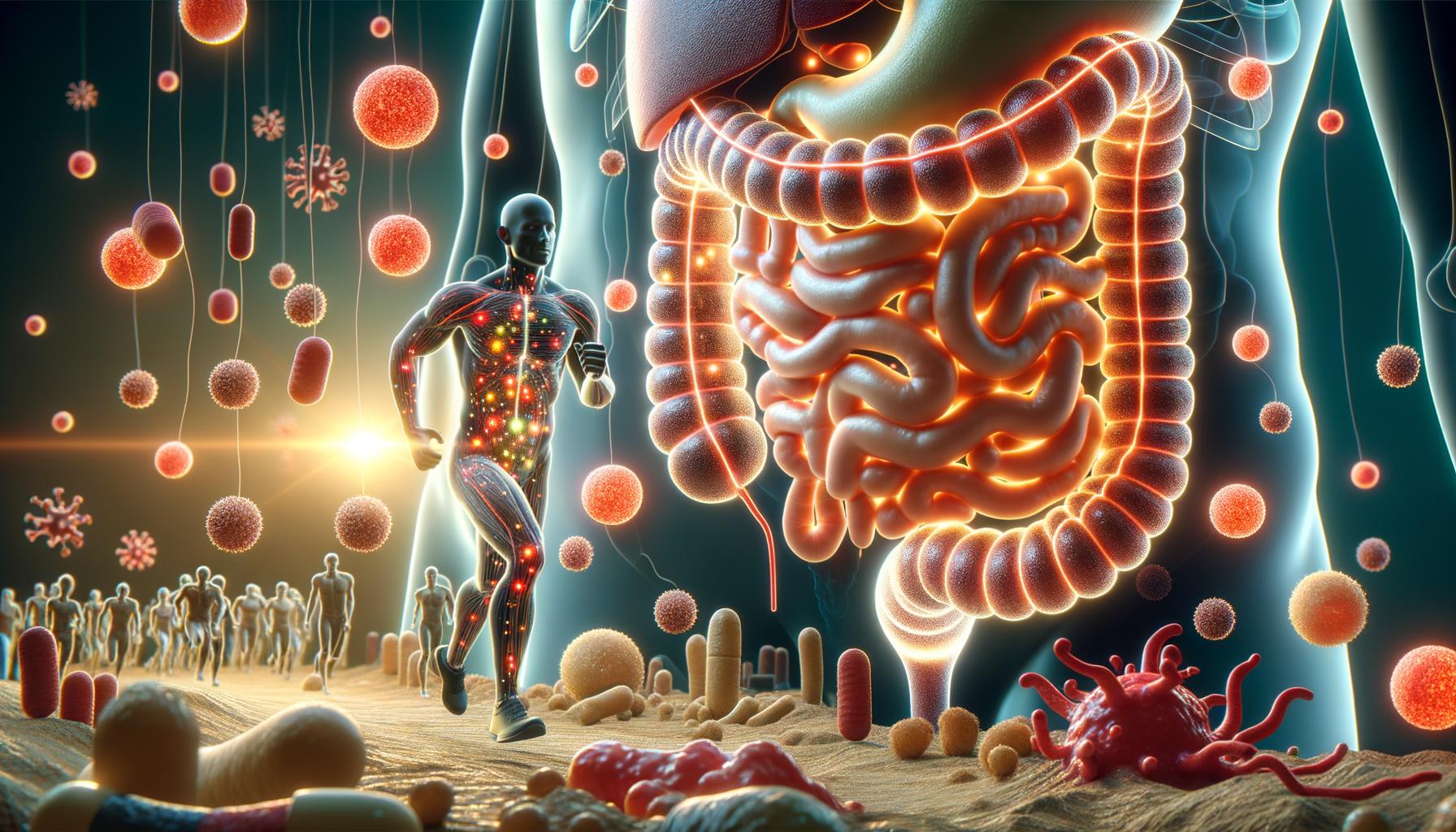· fitness · 17 min read
Boost Your Gut Health with Exercise
Explore how regular physical activity can transform your gut microbiome, boosting health, reducing inflammation, and enhancing mental well-being.

In This Post
The Fact Why Should I Care How To Put In Action Start Tomorrow Guide How does it effect my ability to focus How does it impact my daily life How does it help me make friends How does it help me manage stress How does it effect my mood Summary: Remember Refresher Checklist The Full Research Article CitationsPrint Out The Tomorrow Checklist!
Sign up for our newsletter and receive a copy today, so that, you can start tomorrow! Or the next day, or the day after that. I forget everything and starting things is hard at least for me so these checklists are godsend.
Print Out The Remember Refresher Checklist!
Sign up for our newsletter and download your own copy of the Remember Refresher Checklist, so that, you can easily put it on your fridge and help you stay on target towards your WHY. Every little bit helps.
Introduction to the Gut-Exercise Connection

The Critical Role of the Gut Microbiome in Health
The gut microbiome, a complex community of bacteria, fungi, and viruses living in our digestive system, plays a pivotal role in our overall health. It’s fascinating to think about how these microscopic organisms can have such a profound effect on our bodies. They help with digestion, protect against pathogens, and even influence our immune system and mood. Improving gut health means nurturing this bacterial ecosystem to ensure it’s balanced and thriving.
When we speak of a healthy gut microbiome, we’re talking about the diversity and abundance of beneficial bacteria. These microorganisms are crucial for our wellbeing. They have a job to do, from breaking down food and absorbing nutrients to battling harmful bacteria and producing vitamins. Keeping them happy means we’re on the right track to good health.
How Exercise Influences the Gut Microbiome
Isn’t it amazing to think that moving our bodies can affect the trillions of microbes in our gut? Regular physical activity has been shown to enhance the diversity and richness of the gut microbiota. This is key for our health. Exercise can promote the growth of beneficial bacteria which contribute to reducing inflammation, strengthening the immune system, and even improving mood and mental health.
Physical fitness isn’t just about heart health and muscles; it also significantly impacts our intestinal health. By engaging in regular exercise, we’re supporting our gut in ways we might not even realize. Here’s a simple checklist to help you integrate exercise into your daily routine for gut health:
- [ ] Dedicate at least 150 minutes to moderate aerobic activity weekly
- [ ] Include strength-training exercises at least two days a week
- [ ] Try gut-friendly exercises like yoga or pilates for stress reduction
- [ ] Schedule short, brisk walks during your day
- [ ] Opt for activities you enjoy to ensure consistency
By following these steps, you’ll not only boost your physical fitness but also support your microbiome diversity and, consequently, your overall health. Exercise, by its very nature, prompts changes in our gut flora in a positive manner. This alteration extends beyond mere numbers; it significantly betters the composition of the microbiota, favoring those beneficial bacteria linked to health improvements.
In summary, the connection between gut health and exercise is an exciting field, revealing how lifestyle modifications, specifically regular physical activity, can dramatically impact our microbiome diversity and, by extension, our health. It’s a symbiotic relationship where movement nourishes and cultivates a balanced ecosystem within us, leading to numerous health benefits.
Understanding the Gut Microbiome

Maintaining a healthy gut is pivotal for overall well-being. The gut microbiome, a complex ecosystem within our bodies, plays a significant role in this process. Let’s delve into what makes up the gut microbiome and explore the link between gut health and our overall well-being.
What Makes Up the Gut Microbiome?
The gut microbiome is composed of trillions of microorganisms, including bacteria, viruses, fungi, and others living in our digestive tract. Among these, beneficial bacteria are crucial for maintaining gut health. These microorganisms help in processing undigested food, producing vitamins, and protecting against pathogens.
A healthy gut flora is marked by its diversity. A varied microbiome is capable of withstanding shocks and stresses from environmental or lifestyle changes. Regular physical activity has been identified as a factor that can improve the diversity and functioning of the gut microbiome. Here’s a simple checklist of factors contributing to a healthy gut microbiome:
- Diversity of microbial species
- Abundance of beneficial bacteria
- Regular intake of prebiotics and probiotics
- Fiber-rich diet
- Regular physical activity
The Link Between Gut Health and Overall Well-being
The importance of gut health extends far beyond the digestive system. It’s closely tied to several aspects of our physical and mental health. Here’s how a healthy gut contributes to overall well-being:
- Immune Function: Most of the immune system resides in the gut. A diverse and balanced microbiome supports a robust immune response, aiding in the prevention of infections and chronic diseases.
- Mental Health Benefits: The gut-brain axis is a communication network linking the central nervous system to the gut. Beneficial gut bacteria can produce neurotransmitters like serotonin, influencing mood and mental health.
- Digestive Health: A healthy microbiome aids in the digestion of food, absorption of nutrients, and production of essential vitamins. It can also help prevent constipation and bloating.
- Chronic Disease Prevention: Research suggests that gut health impacts the risk of developing chronic conditions, such as obesity, type 2 diabetes, and heart disease.
To harness these benefits, lifestyle modifications, including incorporating regular physical activity and a balanced diet, are essential. Exercise stimulates the growth of beneficial gut bacteria, promoting microbiome diversity and enhancing gut health. Coupled with nutritional interventions, such as increasing fiber intake and incorporating fermented foods, it creates a synergistic effect, boosting gut health and overall wellbeing.
By understanding the critical role of the gut microbiome and its impact on health, individuals can make informed choices toward improving their gut flora through diet, exercise, and lifestyle changes. This, in turn, lays the foundation for a healthier, more vibrant life.
The Impact of Regular Exercise on the Gut

Exercise is more than just a way to improve physical appearance or athletic performance. It plays a significant role in maintaining a healthy gut microbiome, influencing overall wellness. This part of the article dives into how different forms of exercise affect gut health and presents the scientific evidence supporting the positive impacts of physical activity on the microbiome.
Different Types of Exercise and Gut Health
A healthy gut relies on a balance and diversity of microbiota. Different exercises can stimulate this environment in various ways, promoting gut health. Here is a simple checklist to guide you through gut-friendly exercises:
- [ ] Aerobic exercises like running, cycling, and swimming to increase gut flora diversity
- [ ] Yoga and Pilates for stress reduction, which positively affects the gut-brain axis
- [ ] Resistance training to enhance metabolic benefits and support beneficial bacteria growth
- [ ] Moderate-intensity exercises ideal for preventing gut dysbiosis
- [ ] Incorporate variety in your exercise regimen to support overall intestinal health
These activities contribute to the flourishing of beneficial bacteria within the gut. Aerobic exercises, in particular, have been highlighted for increasing the diversity of the microbiome, which is crucial for gut health. Similarly, activities that reduce stress, like yoga, support the gut-brain axis, further enhancing microbial balance.
Scientific Evidence: Exercise’s Positive Effects on the Microbiome
Studies have consistently supported the claim that regular physical activity positively influences the gut microbiome. For instance, research indicates that exercise can enhance the richness and diversity of gut microbiota. This is critical since a diversified gut microbiome is linked to improved immune function, reduced inflammation, and lower risks of chronic diseases.
One study observed significant changes in the gut flora of professional athletes, showcasing elevated levels of health-promoting bacteria compared to non-athletic controls. Another research found that even short-term exercise interventions could increase microbial diversity, offering rapid benefits to gut health.
Moreover, regular physical activity has been tied to increases in beneficial gut bacteria that produce short-chain fatty acids (SCFAs). SCFAs play essential roles in maintaining gut lining health, reducing inflammation, and providing metabolic benefits. This evidence underscores the importance of integrating physical fitness into daily routines as a means of nurturing gut health.
It’s clear that exercise does more than just help us look and feel good; it’s a cornerstone of maintaining a balanced and healthy gut microbiome. Whether it’s running, weightlifting, or practicing yoga, regular physical activity is vital for gut health and, by extension, our overall well-being. Engaging in a variety of exercises can stimulate the growth of beneficial bacteria, improve digestive health, and reduce the risk of various health issues. Therefore, incorporating regular exercise into your lifestyle is a powerful way to support your gut health and enhance your quality of life.
Benefits of a Diversified Gut Microbiome

A diverse gut microbiome is like a bustling city, with each microorganism playing a unique role in maintaining the health and harmony of the body. The impact of regular physical activity on fostering microbiome diversity cannot be overstated, bringing numerous health benefits from enhanced immune responses to improved mental and digestive health.
Boosted Immune Function
A well-balanced gut microbiome is a cornerstone of a strong immune system. Beneficial bacteria in the gut interact with immune cells, training them to distinguish between harmful invaders and harmless entities. This interaction helps in reducing the risk of chronic diseases, infections, and even some types of cancer. Regular physical activity contributes to the richness of these beneficial microbes, thereby enhancing the body’s natural defenses.
Reduced Inflammation and Its Effects
Inflammation is the body’s response to injury or infection, but when it becomes chronic, it can lead to health issues such as heart disease, diabetes, and obesity. Exercise has been shown to lower levels of inflammatory markers, partly by promoting a healthy and diverse gut microbiome. A diversified microbial population helps in controlling inflammation by strengthening the gut barrier, limiting the entry of harmful substances that could trigger inflammatory responses.
Enhancements in Mental Health
The gut-brain axis refers to the two-way communication between the gut microbiome and the brain. A diversified gut microbiome can positively impact mental health, contributing to reduced stress levels and lower instances of anxiety and depression. Regular exercise boosts the production of beneficial gut bacteria that produce mood-regulating neurochemicals, thereby supporting mental well-being.
Improved Digestive Function
A diverse microbiome is essential for optimal digestive health, aiding in the breakdown of food, absorption of nutrients, and regular bowel movements. Exercise stimulates the growth of beneficial bacteria strains involved in these processes, enhancing gut motility and preventing conditions such as irritable bowel syndrome (IBS), constipation, and bloating.
Here’s a simple checklist to help incorporate exercise into your routine for a healthier gut microbiome:
- [ ] Schedule regular exercise sessions, aiming for at least 30 minutes of moderate activity
most days of the week.
- [ ] Mix up your exercise regimen to include aerobic activities, resistance training, and
flexibility exercises for microbial diversity.
- [ ] Stay hydrated before, during, and after exercise to support digestive health.
- [ ] Combine physical activity with a diet rich in fibers, probiotics, and prebiotics to
maximize benefits on the gut microbiome.
- [ ] Listen to your body and rest as needed; balance is key to maintaining both physical and
gut health.
By nurturing the diversity of your gut microbiome through regular physical activity, you’re making a valuable investment in your overall health. The synergy between exercise and a diversified microbial community goes a long way in enhancing immune function, reducing inflammation, uplifting mental health, and ensuring proper digestive function. It’s a holistic approach to health that benefits not just the gut but the entire body.
Synergy Between Diet, Exercise, and Gut Health

A holistic approach to health always wins, especially when talking about gut health. The foods you eat and the amount of physical activity you engage in work together to impact your intestinal flora. This synergy between diet, exercise, and gut health plays a crucial role in ensuring the optimum function of your digestive system as well as your overall well-being.
The Role of Diet in Complementing Exercise for Gut Health
Diet and exercise are two sides of the same coin when it comes to enhancing your gut health. While regular physical activity increases microbiome diversity and promotes the growth of beneficial bacteria, the food you consume provides the necessary nutrients these microorganisms need to thrive. A diet rich in prebiotics and probiotics, in particular, can amplify the positive effects of an exercise regimen on gut health.
Prebiotics are dietary fibers found in foods like garlic, onions, and bananas. They act as food for probiotics, which are live bacteria and yeasts beneficial to our health, especially the digestive system. Fermented foods such as yogurt, kefir, sauerkraut, and kombucha are rich in probiotics. Incorporating these items into your diet can significantly complement your exercise efforts, leading to an even healthier gut microbiome.
Lifestyle Tips for Maintaining a Healthy Gut Microbiome
A healthy gut microbiome doesn’t just rely on diet and exercise; it’s also about making smart lifestyle choices. Here’s a quick checklist to help maintain a balanced gut flora:
- Eat a diverse range of foods to promote a diverse microbiome.
- Incorporate plenty of fiber in your diet.
- Choose probiotic-rich foods or consider taking a probiotic supplement.
- Stay hydrated.
- Aim for regular, consistent physical activity.
- Manage stress through mindfulness or meditation.
- Avoid unnecessary antibiotics, as they can harm beneficial gut bacteria.
By following these lifestyle tips, alongside a balanced diet and consistent exercise regimen, you can nurture a thriving population of gut flora. This, in turn, contributes to improved immune function, reduced inflammation, enhanced mental health, and better digestive health. It’s all about creating a harmonious balance that supports the gut-brain axis and leads to a happier, healthier life.
FAQs on Exercise and Gut Health

Exploring the connection between physical fitness and gut health reveals intriguing insights. Frequent questions on this topic provide a deeper understanding of how to optimize gut health through exercise. Here’s a closer look at some commonly asked questions.
How Quickly Does Exercise Affect the Gut Microbiome?
The impact of regular physical activity on the gut microbiome can begin to be noticed relatively quickly, often within a few weeks of consistent exercise. Studies suggest that even short-term exercise regimens can start to increase the diversity of beneficial bacteria in the gut. However, for lasting effects and significant changes in microbiome diversity, it’s essential to maintain a regular exercise routine.
Can Too Much Exercise Harm Gut Health?
Yes, while exercise is generally beneficial for gut health, excessively intense or prolonged physical activity without adequate rest may lead to negative effects on the gut. This can include an increased risk of gut dysbiosis, where the balance of gut bacteria is disrupted, and the intestinal barrier function might be compromised. Listening to your body and ensuring enough recovery time is crucial to avoid these adverse outcomes.
What Are the Best Exercises for Gut Health?
To support a healthy gut microbiome, incorporating a variety of exercises into your routine is beneficial. Here are some gut-friendly exercises:
- Aerobic activities like brisk walking, jogging, or swimming to promote increased blood flow
to the gut.
- Resistance training to enhance muscle mass, which can indirectly support gut health.
- Yoga and pilates for stress reduction, which has a positive impact on the gut-brain axis.
Choosing activities that you enjoy and can consistently engage in is key to reaping the gut health benefits of exercise.
In focusing on the relationship between exercise and gut health, remember that a balance is essential. Regular physical activity, when balanced with proper rest and a nutritious diet, can significantly contribute to improved gut health, enhanced immune function, and overall well-being. Whether you’re a fitness enthusiast or just starting your health journey, embracing physical fitness as a pillar of gut health can lead to profound long-term health benefits.
Conclusion - Embracing the Gut-Exercise Link for Better Health

As we conclude our exploration of the vital connection between gut health and exercise, it’s clear that nurturing our microbiome through regular physical activity is not just beneficial – it’s essential for overall well-being. The journey through the science behind the gut-exercise link, the profound impacts of microbiome diversity on health, and the synergy between diet, exercise, and gut health paints a comprehensive picture. A picture that emphasizes the importance of a holistic approach to maintaining a vibrant and diverse gut flora.
Understanding the intricate relationship between our gut health and lifestyle choices empowers us to make informed decisions. These decisions not only enhance our physical fitness but also our immune function, mental health, and digestive wellness. It’s not just about moving more; it’s about moving with purpose and understanding that each step, stretch, and strength training session contributes to our internal ecosystem’s richness.
Summary and Encouragement for the Reader
Through the lens of scientific evidence and practical advice provided in this series, it’s evident that establishing a regular exercise regimen, complemented by a balanced diet rich in prebiotics and probiotics, is fundamental in fostering a healthy microbiome. This, in turn, sets a strong foundation for preventing chronic disease, reducing inflammation, and boosting mental health.
Embarking on this journey might seem daunting at first, but remembering that small, consistent changes lead to significant impacts is crucial. Here’s a simple checklist to help you incorporate the gut-exercise link into your daily routine for better health:
- [ ] Dedicate at least 30 minutes to physical activity daily, mixing between aerobic and
gut-friendly exercises.
- [ ] Incorporate foods high in fiber, fermented products, and a variety of fruits and
vegetables into your meals.
- [ ] Stay hydrated to help support digestive health and nutrient absorption.
- [ ] Listen to your body and give it enough rest to recover from physical exertion.
- [ ] Consult with a healthcare professional before starting any new exercise regimen,
especially if you have existing health concerns.
Remember, the path to improved gut health and overall wellness is a marathon, not a sprint. It’s about making sustainable lifestyle modifications that not only boost your microbiome diversity but also enhance your life quality. Let the knowledge of the gut-exercise link serve as a guide and inspiration for you to take the necessary steps today towards a healthier tomorrow.
In embracing the profound connection between movement and our microbial inhabitants, we can unlock the door to a healthier, happier life. The journey towards understanding and improving our gut health through exercise is ongoing, but each step forward is a step towards a better version of ourselves. Let’s move, eat, and live in ways that celebrate and nurture our remarkable inner world.
Further Reading on Gut Health and Exercise

Embarking on a journey to improve your gut health through exercise is both exciting and empowering. The connection between physical activity and the microbiome is fundamental to our overall well-being, touching aspects of immune function, mental health, and beyond. As you integrate the insights from this series into your lifestyle, your journey doesn’t have to stop here. For those looking to expand their knowledge and explore more about the intricate world of gut health and the power of exercise, here are three invaluable resources to dive deeper into these topics.
Learn more about your gut microbiome - This link, provided by the National Institutes of Health (NIH), offers a comprehensive gateway into understanding the basics of the gut microbiome. It’s an excellent starting point for anyone looking to grasp the role and importance of gut flora in our health and how lifestyle modifications can positively or negatively affect it.
Exercise guidelines for a healthy heart - The American Heart Association (AHA) has laid down a foundation of fitness recommendations that do more than just bolster cardiovascular health. Regular physical activity is shown to have metabolic benefits, aid in stress reduction, and, as we’ve discussed, support gut health. This resource is perfect for crafting an exercise regimen that aligns with your personal health goals.
How diet influences gut health - Harvard Health (link) offers a treasure trove of information on the nutritional impact on microbiota. By understanding the synergistic relationship between diet and exercise on your gut, you can make informed choices about prebiotics, probiotics, fermented foods, and fiber intake for optimizing your gut flora.
Maximizing Your Learning Experience
To get the most out of these resources, here’s a simple checklist for you to follow:
- [ ] Visit the NIH website to sharpen your foundational knowledge about the gut microbiome.
- [ ] Check out the AHA’s fitness recommendations to align your exercise practices with your
heart and gut health.
- [ ] Explore Harvard Health’s insights on diet and gut health to fine-tune your eating habits
for better microbiome diversity.
- [ ] Apply your learnings by gradually incorporating lifestyle modifications that support gut
health.
- [ ] Monitor and reflect on changes in your overall well-being as you adjust your diet and
exercise regimen.
Utilizing these resources will empower you with knowledge and practical tips to nurture your gut health through informed lifestyle choices. Remember, the journey to better health is continuous, and staying curious and informed is the key to success.





